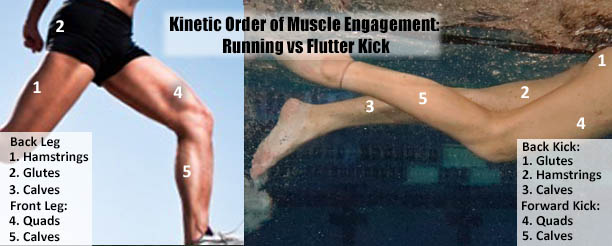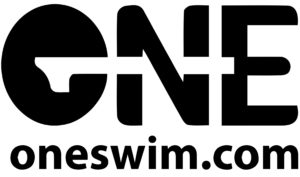courtesy ONEswim.com, a SwimmersBest brand
With our swim team, we have been back in the water for about 2.5 months after we were locked out for a few months. For moderate distance swim races, our swimmers are mostly back to where they left off in practice times. However, when we look at just kick race times, our kicks have been clearly hampered by the time out of the water. This has forced us to look at a range of problems such as a) why is the kick quality recovering more slowly? b) what can we do to speed up the recovery process? c) what can we do during our next lockout to prevent this from being such a problem if this happens again?
The ‘Why’ can be attributed to 2 things: 1) nothing in our normal land-based activities (or even most of our dryland exercises) fully mimics the flutter kick movement, and 2) once we are back in the water, swimmers overcompensate for their lack of proper muscle engagement with bad technique (too much knee bend) which hampers how long it will take for them to recover back to the quality and power they had before the shutdown.
If we start with #1 above, and look at our lack of normal land-based activities that mimic flutter kicking, you can also argue that this is true of our upper body stroke muscles as well. But we are finding that our strokes have recovered faster than our kick quality/power has recovered. And we feel that is mostly due to #2, or that we can cheat with our kick better than we can with our stroke. Just like when we first learned to swim, we used a TON of knee bend because the body has no idea how to engage our glutes in the recovery of our kick. Because we as coaches don’t want to overload the legs of new swimmers to overcome this developmental problem, it tends to lag with the swimmers for many years unless they start putting in more than 8 hours of training per week so that we can really start building on their program.
The problem starts with the way we engage our glute muscles. When we run and bike our order of engagement of muscles is roughly our quads first, then calves, then hamstrings, then glutes and calves. When we are swimming, our forward kick direction (which some call the ‘propulsive’ direction) engages the quads first and then the calves. However, the ‘recovery’ phase of our kick (lifting our leg up) is when we have our problems. This is because we must FIRST engage our glutes, then hamstrings and then calves. Considering how little we engage our glutes at all in land-based activities, it is easy to understand that our glutes quickly stop firing in the proper order when we are out of the water for long periods of time. When our glutes are out of shape or have been out of the water for a long time and have lost their training/technique, the glutes fail to fire at all and we just lift with our hamstrings and calves (bending our knees). This causes us to swim much like we run and bike and thus we come back to the water with an excessive amount of knee bend and a lack of ankle extension. And like typical 8 and 9 year olds, the problem persist longer than it should as the body continues to resist kicking properly. The goal is to rebuild both the muscles and the kinetic order of engagement (‘muscle memory’) with constant focus when we first get back to swimming after a long time out. This involves creating NEW methods and processes to quickly rebuild both the glute engagement and the technique (minimal knee bend) at the same time.
To test this idea for yourself, lay on your stomach on the floor and lift both legs at the same time without ANY knee bend. You will quickly realize how much you need your glutes to do this and start to realize how natural it is for swimmers to NOT use these muscles after a long time out of the water.
Dryland/On Deck:
Because we can naturally ‘cheat’ in the water and just bend our knees more than normal to kick as we get back in the water, we like to start to solve this problem with dryland tools to force elongated kicking with glute engagement. The Dryland Kicking Assembly (http://www.swimmersbest.com/dryland-kicking-assembly/) by Oneswim.com is an ideal way to combine dryland and in-water swimming. It can be set up on any door or between 2 vertical bars (such as 2 legs of a dive block) near the water and you can move swimmers onto the Kicking Assembly and then immediately get them into the water to help connect the ‘muscle memory’ of a glute-engagement flutter kick. Not only does this process train the proper muscle engagement and kick technique but it provides a high intensity cardio work out at the same time. Learn more about the unique topic of ‘swim specific dryland’ training by clicking here.
The Dryland Kicking Assembly is also the ideal way to prevent ‘lazy glute’ kicking by having swimmers attach this device to their bedroom doors during any future extended home stays or time out of the water for shoulder problems, vacations, etc…
In Water
Back in the water we need to load the legs in a way that forces less knee bend and more engagement of the glute muscles. Fins would appear to do this but often just cause swimmers to drop their ankles, and lead with their heels to ‘slice’ their feet upward on the recovery phase of the kick. The Power Bags (http://www.swimmersbest.com/products/drag-gear-power-bags/) by Oneswim.com are designed to not only go on the feet as socks but also over the calves, arms, waist and much more. But over the calves the Power Bags are the ideal way to rebuild lost muscle engagement and kick technique. Wearing them over the calves adds a lot of value because the swimmers have resistance on their calves and must engage more and more of their glutes to overcome that resistance. This provides a more ‘all over’ resistance instead of having them only on the feet. When on the calves the resistance is on the initial ‘recovery’ movement of the legs so that it engages the glutes sooner than any other source of resistance. During the propulsive phase (forward kick) the Power Bags also provide resistance but it is the recovery phase that is causing the bulk of the technique and power problems. When we can create a condition that forces the glutes to engage early, we have reinforced the proper kinetic chain of muscle engagement to produce both better form and increased power.
Although most uses of ‘socks’ such as the Power Bags are over the feet in this industry, we do not recommend that as the bulk of the time spent kicking with them. We like to run a healthy percentage of a kick or swim set with the Power Bags over the calves and then, at the end of the set, just release the top elastic strap and let the Bags fall down over the feet. This is a quick change and a great way to end a kick or swim session. When on the feet, Power Bags should only be used for short distance such as 25 yards or even less. Swimmers will need to kick much faster than normal and with a much straighter leg and very straight ankle. The tactile feel of the bags over the feet will cause swimmers to focus on their toes and elongating their ankles to get any forward propulsion from their kick. Short distances with moderate recovery rest will be critical so that the swimmers can maintain their effort when using the Power Bags on their feet. This provides an excellent High Intensity training session for the cardio system, kick technique improvements, and kick power engagement.
A more direct path to minimizing knee bend and engaging the glutes is to use the FlexRights (http://www.swimmersbest.com/
In order to build muscles in both directions, the Kick Trainer (http://www.swimmersbest.com/
And a simple way to round out your program’s approach to improving your recovery kick muscles is with regular use of Ankle Weights (http://www.swimmersbest.com/
As with everything in swimming, patience and constant focus on long-term goals for each swimmer and each swim group is critical. The recovery muscle kinetic chain is something that constantly needs to be improved. However, with such extended times out of the water, the effort to this problem must include a very intentional and organized approach.
DO YOU LIKE OUR SWIM EDUCATION AND GEAR? JOIN OUR NEWSLETTER.
ABOUT ONESWIM.COM, A SWIMMERSBEST BRAND
ONEswim.com is leading the way for the future of swim training equipment. The company offers a broad range of solutions for improving stroke technique, kick technique, and breathing technique. They provide swimmers, coaches, and teams with the tools they need to balance technique training with conditioning training. By combining the best drills with the best tools, the SwimmersBest products give swimmers instant tactile feedback so they can adjust their technique efficiently. The old way of having coaches constantly remind swimmers of their individual problems has proven to offer very little improvement in technique. All SwimmersBest products are designed to constantly ‘talk to the swimmers’ so they can feel the problems and make corrections. This unique approach means the swimmers are given negative feedback for incorrect stroke technique, which compels the swimmers to quickly correct the problem on their own. With a constant flow of new innovative product designs, SwimmersBest is a company that will continue to deliver solutions you need.
SWIMMERSBEST WEBSITE
SWIMMERSBEST FACEBACK
SWIMMERSBEST TWITTER
SWIMMERSBEST YOUTUBE
SWIMMERSBEST INSTAGRAM
ONEswim.com / SwimmersBest is a SwimSwam partner.







